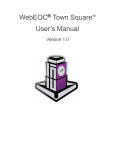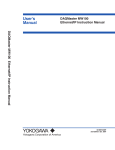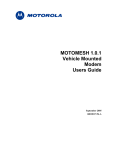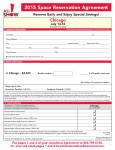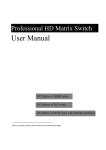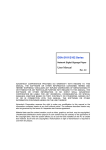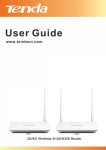Download Nokia E60 Cell Phone User Manual
Transcript
Nokia_E60_Using_WLAN_en_1.fm Page 1 Monday, June 5, 2006 6:04 PM Nokia and Nokia Connecting People are registered trademarks of Nokia Corporation Nokia_E60_Using_WLAN_en_1.fm Page 2 Monday, June 5, 2006 6:04 PM Nokia E60 Using WLAN Legal Notice Copyright © Nokia 2006. All rights reserved. Reproduction, transfer, distribution or storage of part or all of the contents in this document in any form without the prior written permission of Nokia is prohibited. Nokia and Nokia Connecting People are registered trademarks of Nokia Corporation. Other product and company names mentioned herein may be trademarks or trade names of their respective owners. Nokia operates a policy of continuous development. Nokia reserves the right to make changes and improvements to any of the products described in this document without prior notice. Copyright © 2006 Nokia. All rights reserved. Under no circumstances shall Nokia be responsible for any loss of data or income or any special, incidental, consequential or indirect damages howsoever caused. The contents of this document are provided "as is". Except as required by applicable law, no warranties of any kind, either express or implied, including, but not limited to, the implied warranties of merchantability and fitness for a particular purpose, are made in relation to the accuracy, reliability or contents of this document. Nokia reserves the right to revise this document or withdraw it at any time without prior notice. Nokia_E60_Using_WLAN_en_1.fm Page 3 Monday, June 5, 2006 6:04 PM Introduction Introduction The purpose of this document is to guide you in using wireless LAN (WLAN) connections with your Nokia E60. Typical situations in which you might use WLAN with Nokia E60 include, but are not limited to, downloading e-mail with attachments, browsing the web and downloading files, connecting to company network, connecting to a WLAN-capable laptop computer, and sending a document to a WLAN-connected printer. WLAN connections can be used both in public situations, such as when waiting at an airport or staying at a hotel, and in private wireless networks at your office or home. Nokia E60 supports the following WLAN features: • IEEE 802.11g and 802.11b WLAN standards • Wi-Fi Protected Access 1.0 and 2 (WPA/WPA2) • For interoperability with older WLAN networks, Nokia E60 also supports the legacy static WEP security and dynamic WEP security Note: The typical transmission range of WLAN connections is limited from 30 meters in indoor spaces to 100 meters in open spaces. The range of wireless devices can be affected by metal surfaces, solid high-density materials and obstacles in the signal path. Copyright © 2006 Nokia. All rights reserved. 3 Defining WLAN connection settings Nokia_E60_Using_WLAN_en_1.fm Page 4 Monday, June 5, 2006 6:04 PM Defining WLAN connection settings This chapter discusses the WLAN settings in Nokia E60. Special focus is on the selection of the WLAN security mode. Creating a WLAN Internet Access Point for a WLAN access point Different connectivity settings, including GPRS, WLAN and other technologies, are organized in so called Internet Access Points (IAPs) in your device. For WLAN access point usage, a WLAN IAP can be created. The advantage of using WLAN access point is that you have more control (particularly regarding security) over network traffic because it passes through the access point, and that you can use any resources in the wired network that the WLAN access point is connected to. The most important settings in the WLAN IAP include the network name (SSID), the WLAN security mode, and the security mode specific security settings. 1 Select Menu→ Tools→ Settings→ Connection→ Access It is also possible for WLAN devices to communicate directly with each other without any WLAN access points. This is done via ad hoc networks, which are established by a single user and others can then join in. Ad hoc connections are easy to set up, but they are limited to devices within the wireless transmission range. You can use ad hoc WLAN connections to print a document in your device to a compatible printer, for example. 4 Copyright © 2004 Nokia. All rights reserved. points. 2 The list of existing access points is shown. Press Options→ New access point to create a new Internet access point. To use an existing access point as a basis for the new one, select Use existing settings. To start with an empty access point, select Use default settings. 3 Define the following settings: • Connection name — Type a descriptive name for the Internet access point, such as My WLAN Internet. • Data bearer — Select Wireless LAN. • WLAN netw. name — To enter the service set identifier (SSID), that is, the name that identifies the specific wireless LAN, select Enter manually. The name must be exactly the same as in your Wi-Fi router. If you do not enter the SSID here, you are not able to connect to networks that use a hidden SSID. To select the network from the wireless LANs in range, select Search for netw.. • Network status — Select Hidden if the network you are connecting to is hidden, or Public if it is not hidden. • WLAN netw. mode — Select Infrastructure. In this mode, devices can communicate with each other and with wired LAN devices through a wireless LAN access point. • WLAN security mode — You must select the same security mode that is used in the wireless LAN access point. If you select WEP (wired equivalent privacy), 802.1x, or WPA/WPA2 (Wi-Fi protected access), you must also configure the relevant additional settings as described in step 4. The available modes are: • None — This security mode is commonly used with HTTP based logon. User authentication is performed at a higher layer using a HTML login page. • WEP — This security mode is supported for compatibility with IEEE 802.11 Wired Equivalent Privacy (WEP) networks. Pre-configured static WEP keys are required for this mode. There are two notations in use in the WLAN industry for the WEP key length representation, which sometimes makes things a bit confusing. The reason is that WEP key has a 24 bit common part and some vendors count this as being part of the key length, while some vendors do not. Both notations are equivalent at WLAN protocol level and fully interoperable. Note: The WEP mode provides a lower level of security than the Wi-Fi Protected Access (WPA) mode. If you use the WEP mode, you should change the key regularly. In the WEP mode, the secure connection icon is not displayed. • 802.1x — This security mode is provided in order to support the legacy Dynamic WEP system, and to support networks that are migrating from Dynamic WEP to Wi-Fi Protected Access (WPA/ WPA2). In this mode, Nokia E60 is able to join both dynamic WEP and WPA networks. Dynamic WEP refers to the fact that WEP keys are not static or pre-configured, but they are dynamically generated as part of the Extensible Authentication Protocol (EAP) authentication procedure. If WLAN access points support WPA, then it is recommended to use the WPA/WPA2 security mode instead of this mode. • WPA/WPA2 — The Wi-Fi Protected Access (WPA/ WPA2) security mode provides the highest level of security among the WLAN security modes of Nokia E60. • Homepage — Enter the Web address of the page you want to display as a home page when you use this access point. Note: The settings available for editing may vary. 4 If you selected WPA/WPA2 as the WLAN security mode, define the following in WLAN security sett.: • WPA mode — Select EAP if you want to use an EAP module for authentication. If you select Pre-shared key, type the password (also called a master key) in the field. Note that the same key must be entered in the wireless LAN access point. Copyright © 2006 Nokia. All rights reserved. Defining WLAN connection settings Nokia_E60_Using_WLAN_en_1.fm Page 5 Monday, June 5, 2006 6:04 PM 5 Defining WLAN connection settings Nokia_E60_Using_WLAN_en_1.fm Page 6 Monday, June 5, 2006 6:04 PM • EAP plug-in settings — If you selected EAP, you must also define these settings. See page 7 for more information. • TKIP encryption — To enable TKIP encryption, based on transient keys changed often enough to prevent misuse, select Allowed. All devices in the wireless LAN must either allow or prevent the use of TKIP encryption. If you selected 802.1x as the WLAN security mode, define the following in WLAN security sett.: • WPA mode — Select EAP if you want to use an EAP module for authentication. If you select Pre-shared key, type the password (also called a master key) in the field. Note that the same key must be entered in the wireless LAN access point. Note: 802.1x authenticates and authorizes devices to access a wireless network, and prevents access if the authorization process fails. If you selected WEP as the WLAN security mode, define the following in WLAN security sett.: • WEP key in use — Select which WEP key is used (#1#4). • Authentication type — Select Open or Shared. • WEP key settings — The remaining settings are • EAP plug-in settings — If you selected EAP, you must also define these settings. See page 7 for more information. 6 Copyright © 2006 Nokia. All rights reserved. defined here: WEP encryption — Select the desired WEP encryption key length. Supported options are 64 and 128 bits. The more bits there are in the key, the higher the level of security. WEP keys consist of a secret key and a 24-bit initialization vector. For example, some manufacturers refer to the 104-bit key as a 128-bit key (104+24). Both keys offer the same level of encryption and are therefore interoperable. WEP key format — Select whether you want to enter the WEP key data in Hexadecimal format or in text format (ASCII). It is important that the same notation is used both in the access point and the Nokia E60. WEP key — Enter the WEP key data. The number of characters you can enter depends on the key length you have chosen. Note: Wired equivalent privacy (WEP) encryption method encrypts data before it is transmitted. Access to the network is denied to users who do not have the required WEP keys. When WEP security mode is in use, if your device receives a data packet not encrypted with the WEP keys, the data is discarded. In an Ad-hoc network, all devices must use the same WEP key. 5 After setting up a basic Internet access point for Wireless LAN, select Back to save the settings of your WLAN IAP and exit, or Options→ Advanced settings to define the following advanced settings: • IPv4 settings — Enter the device IP and name server addresses for IPv4 Internet protocol. • IPv6 settings — Select or enter the name server addresses for IPv6 Internet protocol. • Proxy serv. address — Enter the proxy server address. • Proxy port number — Enter the proxy server port number. Proxy servers are intermediate servers between a browsing service and its users, which are used by some service providers. These servers may provide additional security and speed up access to the service. Note: The settings available for editing may vary. Contact your service provider for more information. Defining WLAN connection settings Nokia_E60_Using_WLAN_en_1.fm Page 7 Monday, June 5, 2006 6:04 PM Modifying EAP settings The extensible authentication protocol (EAP) plug-ins are used in wireless networks to authenticate wireless devices and authentication servers, and the different EAP plug-ins make possible the use of various EAP methods (network service). To use an EAP plug-in when you connect to a WLAN using the access point, select the desired plug-in and Options→ Enable. The EAP plug-ins enabled for use with this access Copyright © 2006 Nokia. All rights reserved. 7 Defining WLAN connection settings Nokia_E60_Using_WLAN_en_1.fm Page 8 Monday, June 5, 2006 6:04 PM point have a check mark next to them. To not use a plugin, select Options→ Disable. To edit the EAP plug-in settings, select Options→ Configure. To change the priority of the EAP plug-in settings, select Options→ Raise priority to attempt to use the plug-in before other plug-ins when connecting to the network with the access point, or Options→ Lower priority to use this plug-in for network authentication after attempting to use other plug-ins. The available options may vary. Creating a WLAN Internet Access Point for an ad hoc network 1 Select Menu→ Tools→ Settings→ Connection→ Access points. 8 Copyright © 2006 Nokia. All rights reserved. 2 The list of existing access points is shown. Press Options→ New access point to create a new Internet access point. To use an existing access point as a basis for the new one, select Use existing settings. To start with an empty access point, select Use default settings. 3 Define the following settings: • Connection name — Type a descriptive name for the Internet access point, such as Office ad hoc connection. • Data bearer — Select Wireless LAN. • WLAN netw. name — To enter the service set identifier (SSID), that is, the name that identifies the specific wireless LAN, select Enter manually. The name must be exactly the same as in your Wi-Fi router. If you do not enter the SSID here, you are not able to connect to networks that use a hidden SSID. To select the network from the wireless LANs in range, select Search for netw.. • Network status — Select Hidden if the network you are connecting to is hidden, or Public if it is not hidden. • WLAN netw. mode — Select Ad-hoc. In this mode, devices can send and receive data directly with each other, and no wireless LAN access point is needed. • WLAN security mode — You must select the same security mode that is used in the wireless LAN access point. If you select WEP (wired equivalent privacy), 802.1x, or WPA/WPA2 (Wi-Fi protected access), you must also configure the relevant additional settings as described in step 4. The available modes are: • None — This security mode is commonly used with HTTP based logon. User authentication is performed at a higher layer using a HTML login page. • WEP — This security mode is supported for compatibility with IEEE 802.11 Wired Equivalent Privacy (WEP) networks. Pre-configured static WEP keys are required for this mode. There are two notations in use in the WLAN industry for the WEP key length representation, which sometimes makes things a bit confusing. The reason is that WEP key has a 24 bit common part and some vendors count this as being part of the key length, while some vendors do not. Both notations are equivalent at WLAN protocol level and fully interoperable. Note: The WEP mode provides a lower level of security than the Wi-Fi Protected Access (WPA) mode. If you use the WEP mode, you should change the key regularly. In the WEP mode, the secure connection icon is not displayed • 802.1x — This security mode is provided in order to support the legacy Dynamic WEP system, and to support networks that are migrating from Dynamic WEP to Wi-Fi Protected Access (WPA/ WPA2). In this mode, Nokia E60 is able to join both dynamic WEP and WPA networks. Dynamic WEP refers to the fact that WEP keys are not static or pre-configured, but they are dynamically generated as part of the Extensible Authentication Protocol (EAP) authentication procedure. If WLAN access points support WPA, then it is recommended to use the WPA/WPA2 security mode instead of this mode. • WPA/WPA2 — The Wi-Fi Protected Access (WPA/ WPA2) security mode provides the highest level of security among the WLAN security modes of Nokia E60. • Homepage — Enter the Web address of the page you want to display as a home page when you use this access point. Note: The settings available for editing may vary. 4 If you selected WPA/WPA2 as the WLAN security mode, define the following in WLAN security sett.: • WPA mode — Select EAP if you want to use an EAP module for authentication. If you select Pre-shared key, type the password (also called a master key) in the field. Note that the same key must be entered in the wireless LAN access point. • EAP plug-in settings — If you selected EAP, you must also define these settings. See page 7 for more information. • TKIP encryption — To enable TKIP encryption, based on transient keys changed often enough to prevent misuse, select Allowed. All devices in the wireless Defining WLAN connection settings Nokia_E60_Using_WLAN_en_1.fm Page 9 Monday, June 5, 2006 6:04 PM Copyright © 2006 Nokia. All rights reserved. 9 Defining WLAN connection settings Nokia_E60_Using_WLAN_en_1.fm Page 10 Monday, June 5, 2006 6:04 PM LAN must either allow or prevent the use of TKIP encryption. If you selected 802.1x as the WLAN security mode, define the following in WLAN security sett.: • WPA mode — Select EAP if you want to use an EAP module for authentication. If you select Pre-shared key, type the password (also called a master key) in the field. Note that the same key must be entered in the wireless LAN access point. (#1-#4). • Authentication type — Select Open or Shared. • WEP key settings — The remaining settings are • EAP plug-in settings — If you selected EAP, you must also define these settings. See page 7 for more information. Note: 802.1x authenticates and authorizes devices to access a wireless network, and prevents access if the authorization process fails. If you selected WEP as the WLAN security mode, define the following in WLAN security sett.: 10 • WEP key in use — Select which WEP key is used Copyright © 2006 Nokia. All rights reserved. defined here: WEP encryption — Select the desired WEP encryption key length. Supported options are 64 and 128 bits. The more bits there are in the key, the higher the level of security. WEP keys consist of a secret key and a 24-bit initialization vector. For example, some manufacturers refer to the 104-bit key as a 128-bit key (104+24). Both keys offer the same level of encryption and are therefore interoperable. WEP key format — Select whether you want to enter the WEP key data in Hexadecimal format or in text format (ASCII). It is important that the same notation is used both in the access point and the Nokia E60. WEP key — Enter the WEP key data. The number of characters you can enter depends on the key length you have chosen. • IPv6 settings — Select or enter the name server addresses for IPv6 Internet protocol. • Ad-hoc channel — Select User defined to manually enter a channel number (1-11). • Proxy serv. address — Enter the proxy server address. • Proxy port number — Enter the proxy server port number. Proxy servers are intermediate servers between a browsing service and its users, which are used by some service providers. These servers may provide additional security and speed up access to the service. Note: The settings available for editing may vary. Contact your service provider for more information. Note: Wired equivalent privacy (WEP) encryption method encrypts data before it is transmitted. Access to the network is denied to users who do not have the required WEP keys. When WEP security mode is in use, if your device receives a data packet not encrypted with the WEP keys, the data is discarded. In an Ad-hoc network, all devices must use the same WEP key. 5 After setting up a basic Internet access point for Wireless LAN, select Back to save the settings of your ad hoc IAP and exit, or Options→ Advanced settings to define the following advanced settings: • IPv4 settings — Enter the device IP and name server addresses for IPv4 Internet protocol. Defining other WLAN settings To access the other WLAN settings, select Menu→ Tools→ Settings→ Connection→ Wireless LAN. Copyright © 2006 Nokia. All rights reserved. Defining WLAN connection settings Nokia_E60_Using_WLAN_en_1.fm Page 11 Monday, June 5, 2006 6:04 PM 11 Defining WLAN connection settings Nokia_E60_Using_WLAN_en_1.fm Page 12 Monday, June 5, 2006 6:04 PM 1 In Show availability, select whether the device should 12 Copyright © 2006 Nokia. All rights reserved. show WLAN availability (Yes or Never). If background scanning is enabled (Yes), the device will detect the availability of WLAN automatically. Various applications can use this information to know when a WLAN network is available. The availability of a WLAN network will be indicated in the user interface with an icon in the top right corner of the screen. If background scanning is disabled (Never), then WLAN networks will only be scanned for when an application is establishing a connection to the Internet. 2 If Show availability is set to Yes, set Scan for networks to the desired value (Every minute, Every 2 minutes, Every 5 minutes, Every 10 minutes). 3 Press Back to save the settings. Note: Selecting Never for Show availability reduces battery consumption. Nokia_E60_Using_WLAN_en_1.fm Page 13 Monday, June 5, 2006 6:04 PM Establishing a WLAN connection Establishing a WLAN connection This chapter describes how you can establish a WLAN connection. It uses a Web browser connection as an example, but other kinds of WLAN connections, such as an ad hoc connection to your printer, work the same way. To establish a WLAN connection: 1 Make sure you have a valid user name and password for the network and that you have created a WLAN IAP as described in “Creating a WLAN Internet Access Point for a WLAN access point” on page 4. 2 Switch on your Nokia E60. 3 Select Menu→ Web. 4 Enter the URL of the Web page that you want to visit, and press Go to. 5 If necessary, select the IAP you created previously, or select Search for WLAN to select from all available WLANs. 6 When your browser is redirected to the authentication page, enter your user name and password. You can now use the connection just like any other connection. If you experience problems with the WLAN connection, make sure that you are within the range of the access point. 7 When you are finished, press Options→ Exit to close the connection and the browser. To close the connection, but leave the browser open, Options→ Advanced options→ Disconnect. Copyright © 2006 Nokia. All rights reserved. 13 Viewing the status of a WLAN connection Nokia_E60_Using_WLAN_en_1.fm Page 14 Monday, June 5, 2006 6:04 PM Viewing the status of a WLAN connection 14 Copyright © 2004 Nokia. All rights reserved. To view the status of your active WLAN connection, select Menu→ Connect.→ Conn. mgr.→ Act. data conn.. 1 Select the network from the list and then select Options→ Details to see the connection status, network name, signal strength, network mode, connection security, TX power, amount of sent and received data, and the duration and speed of the selected active connection. Press OK to close the Details view and Back to return to Conn. mgr.. 2 Select Availab. WLAN to view all WLAN networks that can be accessed and their signal strength. You can select Options→ Details to view their details as described above. Select Options→ Reload to refresh the list. Tip: You can use the Log application to find out information about past connections. Select Menu→ Log to start it. WLAN troubleshooting Some common problems that may occur when using WLAN are discussed in this section. • Wrong proxy settings: if you cannot browse the Web even though the WLAN connection is working and the IP settings seem to be correct, check that the HTTP/ HTTPS proxy settings are defined correctly in the advanced settings of your WLAN access point. • Problems with the WEP security mode: if you encounter these, check that the WEP keys have been entered in the correct format (ASCII vs. HEX) and have the right number of characters. ASCII WEP keys are also case sensitive; check that you have not confused any upper or lower case letters in the key. Incorrect WEP keys may cause a situation where Nokia E60 is able to associate with a WLAN network but no data can be transferred. Also remember to check that the WEP authentication mode is correct. In the access point it may be called, for example, “WEP authentication”, “shared-key authentication” or “Wi-Fi security mode”. • Poor signal quality: to check the signal quality of your WLAN connection, select Menu→ Connect.→ Conn. mgr.→ Act. data conn.→ Options→ Details. If the signal quality is weak or even moderate, you may encounter connection problems. Try again nearer the access point. • Wrong security mode: it is possible that you have configured the security mode correctly, but it may not • • • • be the right mode. To check the security mode that the network uses, select Menu→ Connect.→ Conn. mgr.→ Act. data conn.→ Options→ Details. Problems with the WPA/WPA2 or 802.1x security mode: if you encounter these, check the following: 1 Check that the WPA mode is the right one (preshared key or EAP). 2 Check the pre-shared key. 3 Check that all EAP types that are not needed are disabled. 4 Check that EAP type settings are correct (passwords, user names, certificates, etc.). Problems with access point configuration: if you encounter these, check the following: 1 Many WLAN access points contain proprietary “Turbo” mode’s claiming to enhance data rates. These functionalities should be disabled from the IAP if there is any reason to believe that they are causing problems to legacy WLAN terminals. 2 Many interoperability problems are solved by updating the IAP firmware to the latest version. Not all channels are available: if you use the device in the offline mode or in the USA, only channels 1-11 are available. Channels 1-13 are available in Europe. Finally...: remember that all Wi-Fi certified devices are unfortunately not compatible, even if they are supposed to be. Copyright © 2006 Nokia. All rights reserved. WLAN troubleshooting Nokia_E60_Using_WLAN_en_1.fm Page 15 Monday, June 5, 2006 6:04 PM 15
















